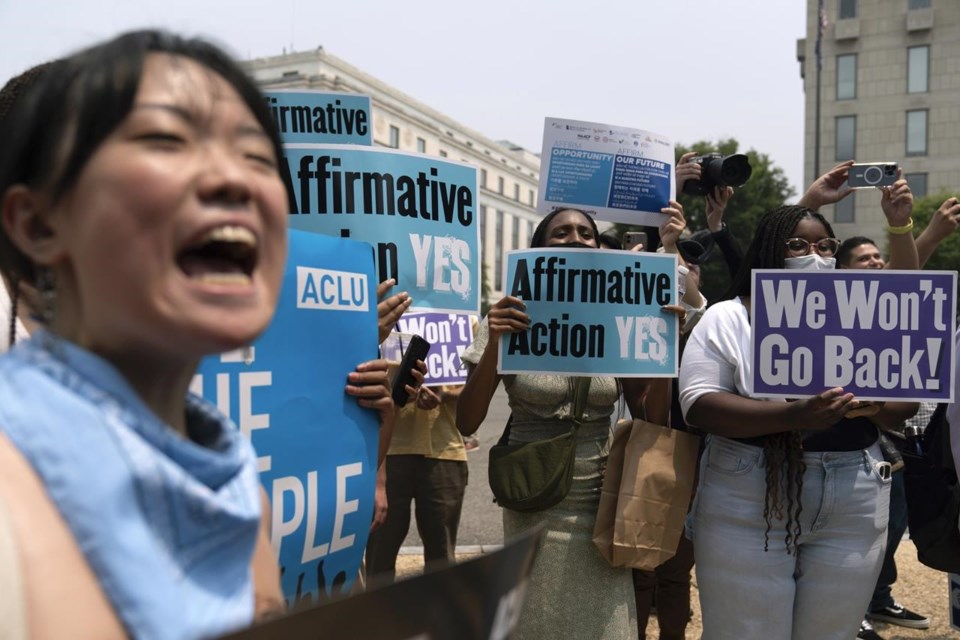WASHINGTON (AP) ŌĆö Chief Justice John Roberts delivered the striking down race-based admissions in higher education, but it was the three justices who make the court the most diverse in its 233-year history who marked the stark, embittered battle lines over affirmative action.
It was a moment heavy with history and emotion. Clarence Thomas, the longest serving justice and the court's second Black justice, read a concurring opinion from the bench, pointedly rejecting the validity of using race as the basis for preferential consideration. He was followed by Sonia Sotomayor, its first Latina, whose dissenting opinion took aim at Thomas. Then came Ketanji Brown Jackson, the court's first Black woman, whose written dissent was its own biting, metaphor-laden rebuke.
The mood in the courtroom Thursday was somber, with most of the justices sitting expressionless, taking occasional sips of water. Both Jackson and Sotomayor looked straight ahead as Roberts read the majority opinion and Thomas his concurrence.
Thomas, who has opposed race-based measures that have come to the court since his confirmation in 1991, focused on how the practice had negatively impacted Asian Americans to the advantage of Black students.
"Although it's not my practice to announce my separate opinions from the bench, the race-based discrimination against Asian Americans in these cases compels me to do so today,ŌĆØ Thomas said.
He said later that "The Constitution continues to embody a simple truth: Two discriminatory wrongs cannot make a right."
Thomas said the nation's racial problems cannot be solved by ŌĆ£affirmative action or some other conception of equity. Racialism simply cannot be undone by different or more racialism.ŌĆØ
Thursday's court ruling, he said, ŌĆ£makes clear that, in the future, universities wishing to discriminate based on race in admissions must articulate and justify a compelling and measurable state interest based on concrete evidence. Given the strictures set out by the court, I highly doubt any will be able to do so.ŌĆØ
Thomas has consistently opposed affirmative action in his career, but until Thursday, had most often been on the losing side of the court's decision.
While his view won, he was not unscathed.
Thomas and Sotomayor sit next to each other as the senior and third-most-senior justices. Both come from humble beginnings and have spoken openly about how affirmative action played a role in their admissions to college and law school.
Any semblance of a shared journey, however, was not in evidence. When Sotomayor read her dissent, the tension was palpable in the ornate, staid chamber with the sculpted marble panels portraying Justice, Wisdom and Truth and a variety of historic figures, from Moses to Mohammad, peering down from above.
While she criticized the majority opinion and said it was rolling back ŌĆ£decades of precedent and momentous progressŌĆØ she saved her most visible ire for Thomas' opinion.
"Justice Thomas offers an ŌĆśoriginalist defense of the colorblind Constitution,ŌĆÖ but his historical analysis leads to the inevitable conclusion that the Constitution is not, in fact, colorblind."
She later criticized Thomas for using race when it suits him and said his arguments played to racial tropes.
ŌĆ£Justice Thomas, for his part, offers a multitude of arguments for why race-conscious college admissions policies supposedly ŌĆśburdenŌĆÖ racial minorities. None of them has any merit,ŌĆØ she said. ŌĆ£He first renews his argument that the use of race in holistic admissions leads to the ŌĆśinevitable underperformanceŌĆÖ by Black and Latino students at elite universities ŌĆśbecause they are less academically prepared than the white and Asian students with whom they must compete.ŌĆÖ ŌĆØ
Jackson, who recused herself from the case involving Harvard because she had been an advisory board member there, called the decision ŌĆ£truly a tragedy for us all.ŌĆØ
The 6-3 decision had been foretold since before Jackson was elevated to the court in 2022 with twin cases involving Harvard and the University of North Carolina heading for rulings. The court had grown more conservative during President Donald TrumpŌĆÖs administration, particularly after the death of the liberal Justice and her replacement in 2020 by conservative Justice .
ŌĆ£With let-them-eat-cake obliviousness, today, the majority pulls the ripcord and announces ŌĆścolorblindness for allŌĆÖ by legal fiat," Jackson wrote. "But deeming race irrelevant in law does not make it so in life."
She said the court had ŌĆ£detached itself from this countryŌĆÖs actual past and present experiences.ŌĆØ
In her footnotes, Jackson said Thomas ŌĆ£demonstrates an obsession with race consciousness that far outstrips my or UNCŌĆÖs holistic understanding that race can be a factor that affects applicantsŌĆÖ unique life experiences.ŌĆØ She added that the takeaway is that ŌĆ£those who demand that no one think about race (a classic pink-elephant paradox) refuse to see, much less solve for, the elephant in the roomŌĆöthe race-linked disparities that continue to impede achievement of our great NationŌĆÖs full potential.ŌĆØ
Although legal barriers are gone, race still matters, she said. ŌĆ£The best that can be said of the majorityŌĆÖs perspective is that it proceeds (ostrich-like) from the hope that preventing consideration of race will end racism.ŌĆØ
Gary Fields, The Associated Press




